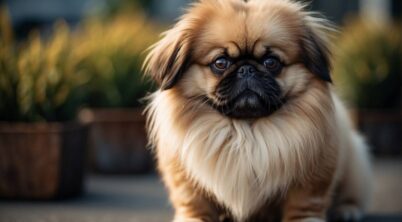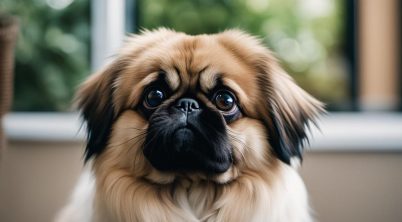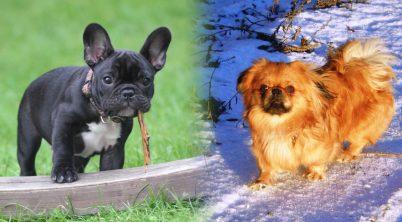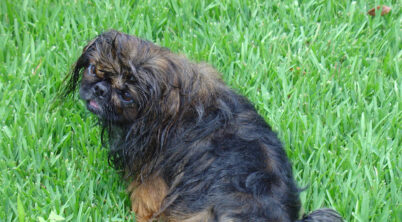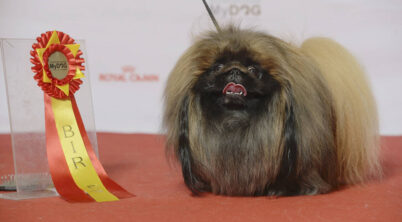The Pekingese is a small-sized dog breed with a long and rich history, originally bred in the imperial Chinese court. Despite their diminutive size, they carry a confident and regal presence that befits their royal ancestry. The adult size of the Pekingese typically ranges from 6 to 9 inches in height at the shoulder, indicating their classification as a toy breed.
Understanding the growth pattern of this breed involves referring to a growth chart that estimates their development from puppyhood to adulthood. Puppies born smaller or larger than average may mature at different rates, but generally, a full-grown Pekingese weighs between 7 to 14 pounds. This breed is characterized by a stocky, muscular build, and weight is a key factor in show standards—the American Kennel Club sets a strict weight limit of 14 pounds for competitors in conformation shows.
Owners can monitor their Pekingese’s growth by paying close attention to their diet and ensuring a healthy lifestyle. It’s important to note that due to their stature, Pekingese do not require extensive accommodations that larger breeds might. Nevertheless, understanding their growth expectations is essential for proper care and to anticipate their needs as they reach adult size.
Table of Contents
Pekingese: How Big Do They Get?
When considering bringing a Pekingese into one’s home, it’s essential to understand their growth pattern and the size they reach at maturity. They are small dogs with adult weights ranging from 7 to 14 pounds and standing 6 to 9 inches tall.
Growth Chart and Milestones
Pekingese puppies generally follow a consistent growth chart, reaching their full size around their first birthday. Notable milestones in a Pekingese’s growth include:
- 3 Months: A Pekingese puppy will weigh between 3 and 6 pounds.
- 6 Months: The weight is expected to be roughly double the 3-month mark, usually between 6 and 12 pounds.
- 1 Year: By this age, most Pekingese will have reached their adult weight, which should not exceed 14 pounds according to the American Kennel Club (AKC) standards.
It’s imperative to monitor a Pekingese puppy’s growth to ensure they are on the right track, without becoming overweight, which could lead to health problems.
Expected Adult Size and Weight
The adult size of a Pekingese dog is compact, with a height at the shoulder ranging from 6 to 9 inches. Their weight is notably regulated by breed standards with a clear cap:
- Weight: An adult Pekingese should weigh between 7 to 14 pounds.
- Height: They stand 6 to 9 inches tall at the shoulder.
Breeders and enthusiasts prioritize meeting these standards, especially for dogs that participate in shows, where any Pekingese over 14 pounds is automatically disqualified from competing. A fully grown Pekingese exudes a stocky and muscular physique despite its small stature, encapsulating the breed’s regal origins and heritage.
Pekingese Health and Wellness
Pekingese dogs are generally robust with a life expectancy of 12 to 15 years. They require regular veterinarian check-ups to ensure they maintain good health. A major concern for the breed is their susceptibility to obesity. Maintaining an appropriate diet and nutrition is critical. Their meals should be well-balanced, with sufficient protein to support a muscular physique while avoiding excessive weight gain.
Respiratory Issues: Given their flat faces, Pekingese are prone to breathing difficulties. Owners should watch for signs of distress, particularly during hot weather or exercise.
Eye Conditions: Their large, prominent eyes can develop problems like ulcers. Regular cleaning and exams are advisable.
Skin Fold Dermatitis: The distinctive facial wrinkles of Pekingese must be kept clean to prevent irritation or infection.
Dietary Needs:
- Protein: High-quality protein sources are essential for muscle and coat health.
- Fat: Provides energy but should be given in moderation to avoid obesity.
- Fiber: Aids in digestion and helps prevent constipation.
Regular exercise tailored to their ability helps keep Pekingese in shape. However, caution is advised to prevent overexertion, which can exacerbate breathing issues.
Owners should ensure that their Pekingese do not overeat and that treats are given in moderation. A balanced diet, along with monitored exercise, contributes significantly to the overall health and wellness of a Pekingese.
Physical and Grooming Needs
The Pekingese breed presents a unique set of physical and grooming requirements due to its distinctive characteristics. They are known for their regal bearing and lion-like appearance, traits highly valued by enthusiasts of the breed.
Size and Build:
Pekingese are small dogs with a stocky, muscular build. Typically, they stand about 6 to 9 inches tall at the shoulder and weigh between 7 to 14 pounds when fully grown.
Coat Colors and Texture:
This breed boasts a double coat that includes a thick, soft undercoat and a longer, coarse overcoat. Their fur comes in various colors and patterns, facing no color restrictions. Common colors include red, fawn, black, and sable, often with a black mask on the face.
Grooming Needs:
- Brushing: Daily brushing is crucial to maintain their long, luxurious coat and to prevent mats and tangles.
- Bathing: Regular baths help to keep their coat clean; however, it’s essential to dry the thick coat thoroughly to prevent skin issues.
- Face Cleaning: They have a brachycephalic facial structure, meaning they have flat faces and short noses, which can lead to tear stains and skin folds that require regular cleaning to prevent irritation or infection.
Exercise:
Despite their appearance, Pekingese require exercise to maintain a healthy weight and muscle tone. They enjoy short walks and indoor play but are prone to heat exhaustion due to their brachycephalic nature, thus should not be overexerted, particularly in hot weather.
In summary, the Pekingese have specific grooming needs due to their coat type and are moderately active, requiring regular but not strenuous exercise. Regular grooming and adequate physical activity will ensure this breed maintains its trademark rollian appearance and overall well-being.
Pekingese Care and Ownership
Owning a Pekingese is a commitment that includes understanding the lifespan of the breed and the responsibilities that come with it. This section will provide essential information for prospective and current Pekingese owners.
Lifespan Expectancy
The Pekingese typically boasts a lifespan ranging from 12 to 15 years. As a purebred recognized by the American Kennel Club (AKC), regular health check-ups and a suitable diet are crucial for maintaining their well-being throughout their lifespan. Owners should be aware that providing the right care can influence the longevity of their Pekingese companions.
Responsibilities of Pekingese Owners
Pekingese owners have a duty to ensure the availability of high-quality food, regular veterinary care including vaccinations, and preventive measures like neutering or spaying. Socialization with children and other animals should be done carefully as the breed is known to be good with children but may require supervision. Regular grooming is non-negotiable due to their long coat. Meeting these responsibilities is key to the health and happiness of a Pekingese.

